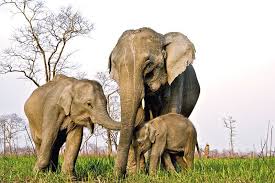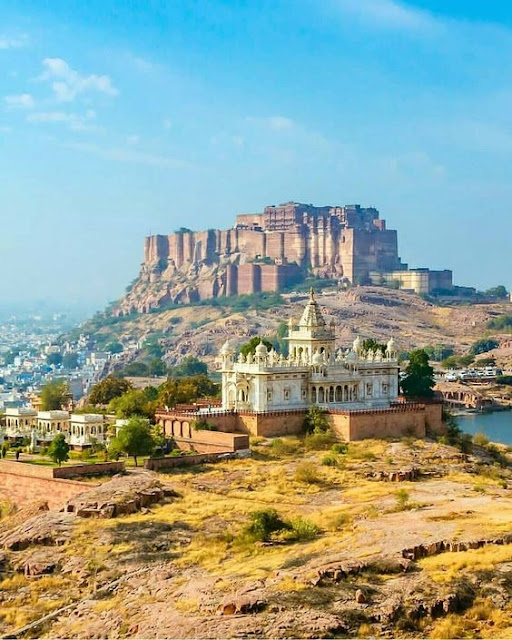Kaziranga National Park Assam, India
Kaziranga National Park
Lying between the latitudes of 26°30' N and 26°45' N, and longitudes 93°08' E to 93°36' E within two districts of Assam, Golaghat and Nagaon, the Kaziranga National Park is stretched across an area of 378 sq km with an addition of 429 sq km along the present boundary of the park.
History
From the land of one-horned rhinos to their protected area, the history of Kaziranga takes us back in the year 1904 when the Viceroy of India, Lord Curzon along with his wife Mary Curzon went on an excursion to this region. To their matter of surprise, they found no signs of rhinos in the concerned area which is known as the home to them and so she decided to put some serious efforts towards their conservation, sine poaching for their skin was on the heights during that time. It was in the year 1905, June 1st that Mary Curzon proposed the idea of converting Kaziranga into a reserve forest by extending the area into 232 sq km.
Wildlife in Park
The land of Kaziranga which is rich in one-horned rhinos and elephants supports the growth and survival of unique and diverse wildlife. Apart from being a rich natural habitat for Rhinos, Kaziranga Sanctuary also has a sizable population of the Wild Buffalos and great herds of wild elephants, sometimes numbering up to 200, including other major counts of species.
Reptiles - Snakes, Lizards, Tortoises, Alligator (Gharial), Crocodile
Kaziranga National Park has chiefly three major types of flora as alluvial inundated grasslands, tropical wet evergreen forests and tropical semi-evergreen forests. But, the main characteristics of flora in Kaziranga are the dense and tall elephant grasses intermixed by small swamplands that are left behind by the receding floodwaters of the river Brahmaputra.
In addition to grasses and forests, Kaziranga National Park includes the abundant cover of water lilies, water hyacinth, and lotus bringing a beautiful scenario to the surroundings. Rattan Cane, which is a type of climbing palm, also adds beauty to Kaziranga National Park. Different vegetation coverage in Kaziranga National Park is tall thickets of elephant grass 41%, short grasses 11%, open jungle 29%, rivers and water bodies 8%, and 6% and swamps 4%.
Best Season to Visit
The best season to visit Kaziranga National Park is between November and April. From 1st of Nov to 30th of April, the park remains open daily for continuous six months being the monsoons as the exceptional season to close the area for safety reasons by the national park management.
Since Kaziranga lies on the banks of Brahmaputra River, every year the reserve area has to face the flooded situation on heavy monsoons leading to great losses and the management has to take great care and precautions to save the precious species. This is the reason it is partially opened during the months of October and May and is completely closed from June to September.
Safari Timings
For Jeep Safari
Jeep Safari is available from 1st November to 30th April and could be possible subject to weather and road conditions on the months of May & October.
Morning Jeep Safari: 07: 09:30
Afternoon Jeep Safari: 13:30: 15:30
Jeep Safari is available from 1st November to 30th April and could be possible subject to weather and road conditions on the months of May & October.
Morning Jeep Safari: 07: 09:30
Afternoon Jeep Safari: 13:30: 15:30
For Elephant Safari
Elephant rides are available from 1st November to 30th April that start in the early morning and continue for 1-1&1/2 hrs.
Elephant Safari Times
| Range | Morning session | Afternoon session(NEW) |
| Burapahar Range, Ghorakati | 5:30 to 7:30 | 15:00 to 16:00 |
| Eastern Range, Agaratoli | 5:30 to 7:30 | 15:00 to 16:00 |
| Kaziranga Range, Kohora | 5:30 to 7:30 | 15:00 to 16:00 |
| Western Range, Bagori | 5:30 to 7:30 | 15:00 to 16:00 |
How to Reach
By Air: Guwahati is located at 217 km from the park serves as the nearest airport to reach Kaziranga. The other airport is located at Jorhat, 97 km from Kaziranga.
By Train: The nearest railhead is at the distance of 75 km from the Kaziranga National Park in Furkating.
By Road: Kohara, located on NH-37 is the main gate to reach the Kaziranga Sanctuary which is facilitated with a handful of cafes and local markets ad this is the area that serves best for commuting by road. ASTM and private buses are easily available from Kohara to Guwahati, Tezpur and upper regions of Assam.
Hotels in Kaziranga
For bringing great days ahead of Kaziranga Rhino tour, the tourists should make some good stays in the area and the presence of great accommodation in the area provides the living more elegant and comfortable along with the elephant safari pleasure in Kaziranga. So, here is the list of best hotels and resorts in Kaziranga National Park for more comfy and stretchable living :
- Jaipuri Ghar
- Iora Resort
- Wild Grass Lodge
- Bonhabi Resort
- Infinity Kaziranga Wilderness
- Kaziranga Resort






Comments